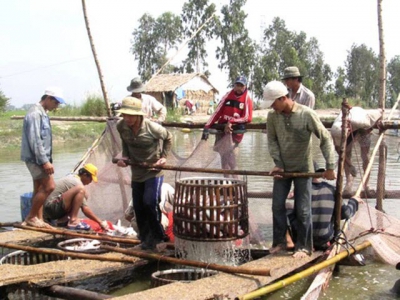Pangasius industry needs resolving difficulties in export

For many past months, the price of pangasius fish in the Mekong Delta hovered around a low level of VND18,000-VND19,000 per kilogram, causing several fish-farming households to suffer huge losses. Many export processing enterprises have also faced difficulties due to the impacts of the Covid-19 pandemic.
Farmers harvest pangasius fish. (Photo: SGGP)
Mr. Tran Dinh Luan, General Director of the Vietnam Directorate of Fisheries, said that since the beginning of this year, the Covid-19 pandemic has developed complicatedly, affecting the business activities of many product lines, including pangasius fish. Statistics showed that in the first four months of this year, the farming area of pangasius fish in Mekong Delta provinces nearly reached 3,907 hectares, accounting for 95.43 percent of that in the same period last year. The estimated production was at 322,364 tons, accounting for 88.15 percent of that in the same period last year. The price of commercial pangasius fish is currently at VND18,000-VND19,000 per kilogram, much lower than the cost prices. As for export, by the end of March, enterprises merely exported US$334 million, down up to 29.3 percent year-on-year.
According to the Directorate of Fisheries, in comparison with the same period last year, pangasius exports to the Chinese market sank 48 percent, to the EU’s market dropped 47.3 percent, and to the US declined 19.8 percent. A rapid decrease has made export enterprises depending on these markets encounter difficulties, thereby dragging down the price of material pangasius fish in the Mekong Delta provinces.
Mr. Duong Nghia Quoc, Chairman of the Vietnam Catfish Association, said concernedly that the price of material pangasius fish has declined since mid-2019, causing farmers to lose VND3,000-VND5,000 per kilogram. Therefore, many households have suspended fish farming as they could no longer withstand the situation. Moreover, the Covid-19 pandemic remains complicated in many countries so the export of pangasius fish continues to be sluggish. Many processing enterprises are holding a large inventory of pangasius fish but they cannot export. Warehouses of some enterprises are already full so they are forced to build new warehouses but face a financial crunch.
Mr. Doan Toi, Chairman of Nam Viet Joint Stock Company, said that the pangasius industry is in a difficult period but the company still struggles to maintain production to provide jobs for thousands of workers. However, if the gloomy export market lasts longer, many enterprises will be exhausted.
According to the Vietnam Association of Seafood Exporters and Producers, it is necessary to reevaluate the current export market. How the Chinese market which accounted for 30-33 percent of the export market share of Vietnamese pangasius fish will recover in the next days. As for the US and European markets, the Covid-19 pandemic remains complicated, so it is essential to have a strategy to bring products into these markets with an appropriate production. Besides, it is important to diversify the consumption market to minimize risks.
Minister Nguyen Xuan Cuong of the Ministry of Agriculture and Rural Development (MARD) emphasized that in May and June this year, enterprises may focus on exporting pangasius fish to the Chinese market, from June and July upwards, they can approach and resume exports to the European market. The Japanese market also favors pangasius products. However, Vietnamese enterprises need to increase the deep processing of pangasius products and improve product quality. At the same time, there will be a program to promote the export of pangasius fish to Russia shortly.
According to Mr. Cuong, in June, the MARD will collaborate with relevant departments to invite large retailers in Vietnam to discuss solutions to stimulate the consumption of pangasius products in the domestic market. If domestic consumption accounts for 10-20 percent of the pangasius production, it will help to ease the pressure for export.
Experts said that based on data in the last five years on importing markets of Vietnamese pangasius fish, it is forecast that the Chinese, US, and European markets continue to be the key markets of Vietnamese pangasius fish in the future, accounting for about 65 percent of the total value.
Mr. Tran Anh Thu, Vice Chairman of the People's Committee of An Giang Province, said that in the long term, there should be a sustainable development strategy because, in the past decades, the pangasius industry has played a strategic role in increasing economic growth of the Mekong Delta provinces, but fish prices were always fluctuating and unstable. If the prices of pangasius fish are too high, enterprises hardly can afford whereas if the prices are too low, farmers will suffer losses. It is essential to have radical solutions to create stability in the production, processing, and export of pangasius fish. Authorities need to have a reasonable short-term and long-term market forecasting strategy; plan and strictly manage farming areas in terms of area and output; invest in fingerlings to improve the quality of commercial pangasius.
Có thể bạn quan tâm
Phần mềm

Phối trộn thức ăn chăn nuôi

Pha dung dịch thủy canh

Định mức cho tôm ăn

Phối trộn phân bón NPK

Xác định tỷ lệ tôm sống

Chuyển đổi đơn vị phân bón

Xác định công suất sục khí

Chuyển đổi đơn vị tôm

Tính diện tích nhà kính

Tính thể tích ao hồ




 Harsh summer hits thousands of hectares of shrimp…
Harsh summer hits thousands of hectares of shrimp…  Covid-19 causes tra fish export disruptions
Covid-19 causes tra fish export disruptions